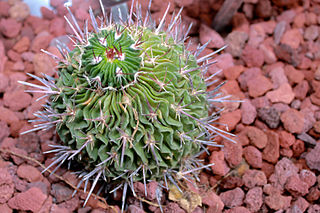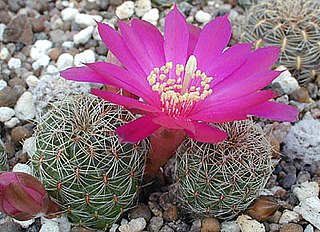
Opuntia microdasys is a species of flowering plant in the cactus family Cactaceae, native and endemic to central and northern Mexico.

Ferocactus glaucescens, the glaucous barrel cactus, is a species of flowering plant in the family Cactaceae, native endemic to México.

Parodia magnifica is a species of flowering plant in the family Cactaceae, native to southern Brazil. One of several species called ball cactus, it is also called balloon cactus. It grows to 7–15 cm (3–6 in) tall by 45 cm (18 in) broad, with heavily ribbed, spherical to columnar, spiny and hairy stems, bearing pale yellow flowers in summer. Its natural habitat is cool, dry temperate grassland at elevations of up to 800 m (2,600 ft). Populations are sparse and fragmented, and it has been designated as “Endangered” by the IUCN Red List.

Rebutia minuscula is a species of cactus from South America found in northern Argentina and Bolivia. It is the type species of the genus Rebutia. As its synonym Rebutia senilis it has gained the Royal Horticultural Society's Award of Garden Merit. Its cultivars 'Krainziana', 'Marsoneri' and 'Violaciflora' are also listed as having gained the Award of Garden Merit.

Mammillaria hahniana, the old lady cactus, is a species of flowering plant in the family Cactaceae, native to central Mexico. It grows to 25 cm (10 in) tall by 50 cm (20 in) broad. The solitary spherical stems, 12 cm in diameter, are covered in white down and white spines. Reddish purple flowers are borne in spring and summer, sometimes forming a complete ring around the apex of the plant.

Mammillaria plumosa, the feather cactus, is a species of flowering plant in the family Cactaceae, native to Northeastern Mexico.

Mammillaria bocasana is a species of cactus in the subfamily Cactoideae. It is often sold as a "powder puff" cactus, and also as a "Powder Puff Pincushion." The plant is protected from collecting in the wild in Mexico.

Stenocactus multicostatus, the brain cactus, is a member of the cactus family native to the deserts of Mexico, and is popular in the gardening community. It has gained the Royal Horticultural Society's Award of Garden Merit.

Thelocactus bicolor, the glory of Texas, is a species of flowering plant in the cactus family, widely distributed in the northern Chihuahuan Desert of Texas and Mexico.

Mammillaria sphaerica, the longmamma nipple cactus or pale mammillaria is a species of flowering plant in the cactus family Cactaceae, native to south eastern Texas in the USA and north eastern Mexico, where it occurs in scattered patches at altitudes up to 1,000 m (3,300 ft). It forms clumps of small pale green spheres to 5 cm (2.0 in) in diameter, with short hairs and pale yellow flowers up to 3 cm (1.2 in) wide in summer.

Weingartia canigueralii is a species of cactus in the genus Weingartia, native to Bolivia. It has gained the Royal Horticultural Society's Award of Garden Merit.

Weingartia mentosa, the crown cactus, is a species of cactus in the genus Weingartia, native to Bolivia. It has gained the Royal Horticultural Society's Award of Garden Merit.

Weingartia neocumingii, the Cuming crown cactus, is a species of cactus in the genus Weingartia, endemic to Bolivia. It has gained the Royal Horticultural Society's Award of Garden Merit.

Weingartia steinbachii, called Steinbach's crown cactus, is a species of cactus in the genus Weingartia, native to Bolivia. It has gained the Royal Horticultural Society's Award of Garden Merit.

Thelocactus macdowellii, called the Chihuahuan snowball, is a species of cactus native to northeastern Mexico. It has gained the Royal Horticultural Society's Award of Garden Merit.

Echinocereus scheeri is a species of hedgehog cactus in the family Cactaceae, native to northern Mexico. With its dramatic offsets, it has gained the Royal Horticultural Society's Award of Garden Merit.

Mammillaria laui is a species of cactus in the genus Mammillaria, native to Tamaulipas state in Mexico. A number of subspecies were described, occurring along an elevation gradient; these are no longer accepted. It is listed as Critically Endangered (CR) in the wild. As Mammillaria lauii it has gained the Royal Horticultural Society's Award of Garden Merit.

Pfeiffera monacantha, the one‑spined wickerware cactus, is a species of epiphytic cactus, native to Bolivia and northwest Argentina. As its synonym Rhipsalis monacantha it has gained the Royal Horticultural Society's Award of Garden Merit.

Disocactus speciosus, the sun cactus, is a species of flowering plant in the family Cactaceae. It is native to Mexico, Honduras and Guatemala, and has been introduced to the Canary Islands. As its synonym Heliocereus speciosus it has gained the Royal Horticultural Society's Award of Garden Merit.

Weingartia cintia is a small alpine cactus native to the high Andes of Bolivia. The plant was discovered by Karel Kníže in 1969 at an elevation of 4,000 m (13,000 ft) near Otavi, in Potosí Department, Bolivia. However, it was not formally described until 1996 by Jan Říha. The genus is named after the town of Cinti in Chuquisaca Department.






















